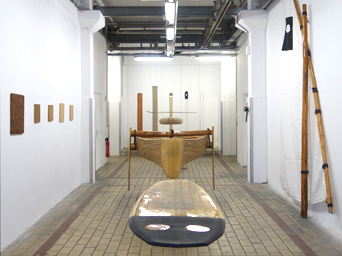
0-2000 2024
Exposition – La Station, Nice
0 m : altitude de croissance de la canne de Provence
2000 m : altitude de croissance du mélèze
Le design d’Antoine Boudin est profondément ancré dans son territoire de vie et de travail, la Provence, qu’il qualifie de “région-continent”dont la diversité des ressources et des paysages est le point de départ de ses recherches.
Il s’intéresse à deux végétaux qui peuplent et cernent son territoire, la canne de Provence et le mélèze, reliant la Méditerranée aux Alpes, la mer à la montagne.
En assumant une posture vernaculaire, il invoque aussi bien botanique, anthropologie, économie, culture, usages et besoins. Il travaille des matériaux provençaux et renouvelables qu’il invite à reconsidérer en démontrant leur potentiel et leur qualité comme des alternatives possibles aux matériaux pétro-sourcés.
À travers différents objets et matières produits au cours des 12 dernières années, cette exposition fait un état des lieux des alternatives imaginées par le designer,
en rupture avec une société de production et de consommation écocide et non-soutenable qui surexploite des ressources finies et détruit les écosystèmes.
Ses alternatives reposent sur l’articulation de 4 principes : le choix de matériaux renouvelables locaux, la valorisation de “déchets” végétaux, l’éco-conception pour limiter la quantité de ressources nécessaires et la production de déchets, et la réduction et le remplacement de l’usage de matières issues du pétrole.
Ainsi, Antoine Boudin remplace les couverts en plastique par un kit nomade en canne de Provence, substitue des âmes de skis et de surfs habituellement fabriquées en mousse polyuréthane par des matériaux naturels (canne, agave, frêne et mélèze pour le noyau de ski et inflorescences d’agave pour le pain de surf). Il part des propriétés de la canne de Provence pour construire dériveur et paddle, réduisant ainsi de près de 90% la quantité de résine, de fibres de verre et de carbone nécessaires.
Parmi les objets présentés, beaucoup sont des invitations au voyage, des objets plus naturels pour arpenter des espaces naturels.
Ils sont la démonstration qu’une utopie concrète est possible, ils proposent de nouvelles manières de faire et de penser et diffusent un nouveau récit.
0-2000 2024
Exhibition – La Station, Nice
0 m : altitude at which Provence cane grows
2000 m : altitude at which the larch tree grows
Antoine Boudin’s design is deeply rooted in the area where he lives and works, Provence, which he describes as a “region-continent” whose diversity of resources and landscapes is the starting point for his research.
He is interested in two plants that populate and encircle his territory, the cane of Provence and the larch, linking the Mediterranean to the Alps, the sea to the mountains.
Assuming a vernacular stance, he invokes botany, anthropology, economics, culture, uses and needs. He works with Provençal and renewable materials, which he invites us to reconsider by demonstrating their potential and quality as possible alternatives to petro-sourced materials.
Through a variety of objects and materials produced over the last 12 years, this exhibition takes stock of the alternatives imagined by the designer,
in a break with an ecocidal and unsustainable production and consumption society that overexploits finite resources and destroys ecosystems.
His alternatives are based on the articulation of 4 principles: the choice of local renewable materials, the valorization of plant “waste”, eco-design to limit the quantity of resources needed and the production of waste, and the reduction and replacement of the use of petroleum-based materials.
For example, Antoine Boudin replaces plastic cutlery with a nomadic kit made from cane from Provence, and substitutes natural materials (cane, agave, ash and larch for the ski core, and agave inflorescences for the surfboard bun) for the ski and snowboard cores usually made from polyurethane foam. He uses the properties of Provençal cane to build dinghies and paddles, reducing the amount of resin, fiberglass and carbon needed by almost 90%.
Many of the objects presented are invitations to travel, more natural objects for surveying natural spaces.
They demonstrate that a concrete utopia is possible, proposing new ways of doing and thinking, and spreading a new narrative.
